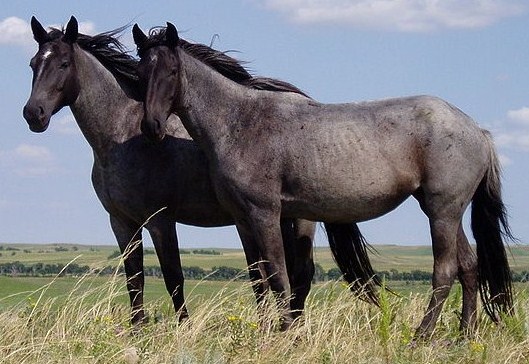Translation
Recordings
Deference to Authority
Guide to a Good Horse (Part 1)
Closing
 |
Back To Top
Abstract
Isidore shares where the longest and shortest lived horses can be found. And he explains what true horsemen look for in a sturdy specimen.
Back To Top
Translation
[44] "Truly either because of sadness or joy horses struggle to comprehend future events. Long lived horses are Persian, Hunnish, those of Epirus, and Sicily which can live at most to 50 years, but short lived horses are those from Spain and Numidea and Gaul, as is frequently conjectured.
[45] "Among high born horses, according to veterans, these are the four things to watch for: shape, beauty, kindness, and color. Shape is a healthy and solid body, strength matching size, a long side, a maximally tight and round buttocks, a broad chest side, a body knotted with dense muscle all over, healthy hooves, and fine curved ears.
[46] "Beauty is a small and healthy head, skin closely adhering to bones, short and graceful ears, large eyes, open nostrils, an erect neck, dense hair and tail, smooth and solid piercing hooves."
(St. Isidore of Seville, Etymologiae 12:44-46)
Back To Top
Recordings
Latin:
Modern English:
Back To Top
Deference to Authority
Both of the major points in this week’s section (horses’ lifespan, and what to look for in a good one) are given as opinion. In the case of where the longest and shortest lived horses can be found, the entry is based on what is “frequently conjectured,” (“frequens opinio”) and when Isidore shifts to talk of the key qualities of a good horse, he defers to “veterans” (“veteres”).
Part of the reason for this deference is that the Etymologies isn’t entirely an original work. Rather than writing everything from scratch, Isidore compiled a lot of his entries from other sources, copying them out by hand, of course, but still copying nonetheless.
However, though this kind of copying rankles academics and writers and publishers worldwide today, it was simply how things were done in the middle ages. Not because people were less able to understand things, but, in part, because books were much more difficult to create.
After all, the longer the book, the more velum a person would need, and the more velum needed meant the more sheep or goats had to be killed to provide that velum. All the other parts of the animal would be used, but if it was an animal used for its milk or wool, but a book was something that an animal could only be used for once (though there’s got to be a medieval romance that features a magical, self-resurrecting sheep out there).
Deference to other authorities fits well into such a publishing system, since it keeps things light. Rather than having everyone explain something thoroughly and use up more and more of the time's precious writing materials, writers could just say “as x explained in y.” Though such references were often not so explicit as to give names and titles.
How all of this relates to horses is beyond me, though horse meat is rather tasty, and this first half of the 7th century guide on how to choose a horse makes a little more sense if you keep in mind that mainland Europeans once did (and still do) raise horses for eating.
Back To Top
Guide to a Good Horse (Part 1)
The two key qualities that Isidore outlines here are a horse’s “shape” ("forma") and “beauty” ("pulchritudo"). To modern eyes the first one makes a little bit more sense than the other, but the descriptions of each make it clear why these are relevant criteria.
Shape boils down to health, and what might be known as Body Mass Index (BMI, a ratio of body fat to body mass and height) today. From the sounds of it, a truly shapely horse is one that is firmly outfitted with muscle and that has the minimum amount of fat possible. Otherwise, shape matching size, firm buttocks, and body knotted in muscle would simply be out of the question.
Beauty ties in quite closely to Shape, since it also deals with the health of the horse as well as its aesthetic appeal. Having a small head, erect neck, and skin that closely adheres to bones all suggest an animal that is healthy, and, again, has a minimum amount of fat on it. Assuming that these are horses for riding, and not for eating, this focus on qualities that relate to a low BMI makes sense, as any extra weight would slow down a horse that would already be carrying a grown man. Not to mention, a man who was likely wearing armor of some description.
Back To Top
Closing
There’s very little horsing around in this week’s extract from Beowulf, as Wiglaf rushes to Beowulf’s aid, shares some words of encouragement, and then prepares to defend against the dragon as it rushes on.
Back To Top
No comments:
Post a Comment